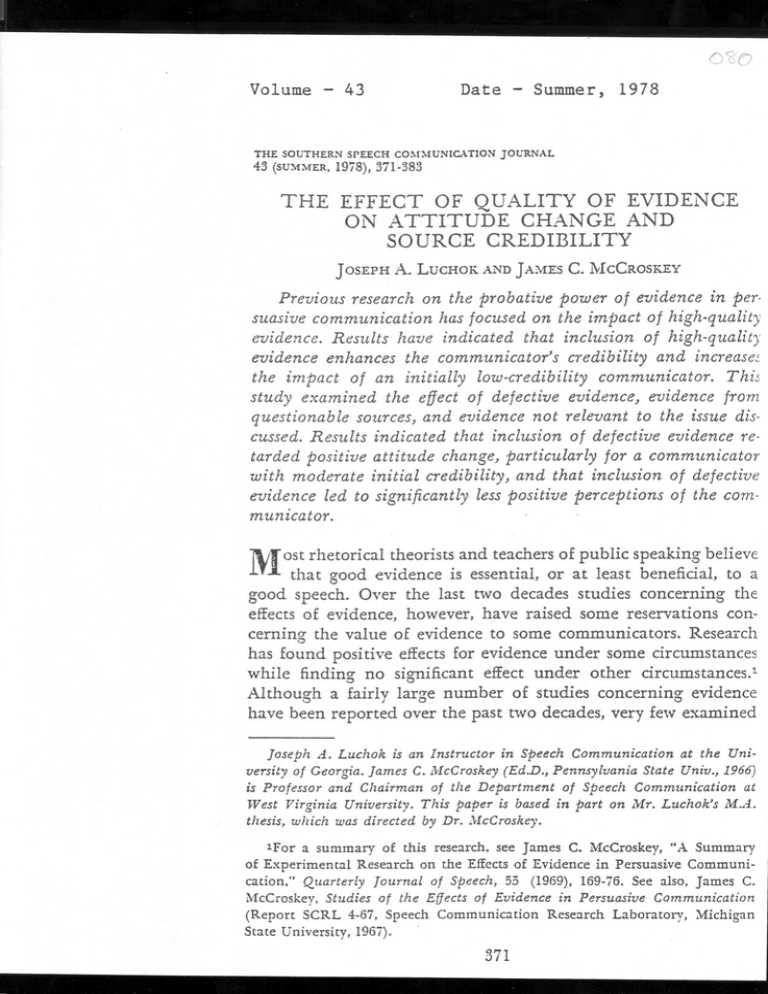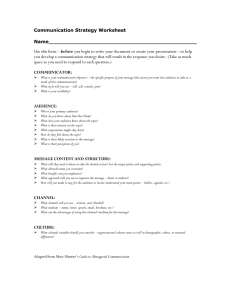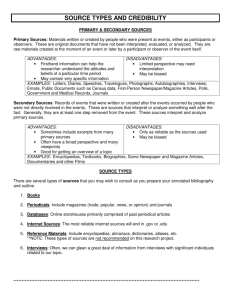ON ATTITUDE CHANGE AND O~O THE EFFECT OF QUALITY OF EVIDENCE
advertisement

O~O
Volume
43
-
THE SOUTHERN
Date - Summer, 1978
SPEECH COMMUNICATION
JOURNAL
43 (SUMMER,1978), 371-383
THE EFFECT OF QUALITY OF EVIDENCE
.......
ON ATTITUDE CHANGE AND
SOURCE CREDIBILITY
] OSEPH
A. LUCHOK AND] AMESC. lVIcCROSKEY
Previous research on the probative power of evidence in persuasive communication has focused on the impact of high-quality
evidence. Results have indicated that inclusion of high-quality
evidence enhances the communicator's credibility and increase:.
the impact of an initially low-credibility communicator. This
study examined the effect of defective evidence, evidence from
questionable sources, and evidence not relevant to the issue discussed. Results indicated that inclusion of defective evidence retarded positive attitude change, particularly for a communicator
with moderate initial credibility, and that inclusion of defective
evidence led to significantly. less positive perceptions of the communicator.
Most
rhetorical theorists and teachers of public speaking believe
that good evidence is essential, or at least beneficial, to a
good speech. Over the last two decades studies concerning the
effects of evidence, however, have raised some reservations concerning the value of evidence to some communicators. Research
has found positive effects for evidence under some circumstances
while finding no significant effect under other circumstances.1
Although a fairly large number of studies concerning evidence
have been reported over the past two decades, very few examined
Luchok is an Instructor in Speech Communication at the University of Georgia. James C. lHcCroskey (Ed.D., Pennsylvania State Univ.,1966)
is Professor and Chairman of the Department of Speech Communication at
West Virginia University. This paper is based in part on iHr. Luchok's M.A..
thesis, which was directed by Dr. }'IcCroske}'.
Joseph
A..
lFor a summary of this research, see James C. McCroskey, "A Summary
of Experimental Research on the Effects of Evidence in Persuasive Communication," Quarterly Journal of Speech, 55 (1969), 169-76. See also, James C.
McCroskey. Studies of the Effects of Evidence in Persuasive Communication
(Report SCRL 4-67, Speech Communication Research Laboratory, Michigan
State University, 1967).
.
371
372
The Southe1.n SPeech Communication Journal
the effect which varying the quality of evidence in a persuasive
message has on attitude change and perceived credibility of the
communicator.
RATIONALE AND
HYPOTHESES
Results of several experiments indicate the presence of an
interaction
between initial communicator
credibility and evidence.:! In each of these studies initial credibility was manipulated
by means of introductions,
and evidence was either included to
support all main points or was omitted. Evidence included was of
high quality; that is, attributed
to a competent, relatively unbiased source and directly supportive of the point under consideration. Inclusion of such evidence was found to result in more
.
attitude change when the communicator was perceived initially
to have moderate or low credibility, but inclusion of evidence by
a communicator perceived initially as highly credible did not result in a significant increase in immediate attitude change.
The theoretical explanation of the previously observed interaction between communicator credibility and evidence hinges on
the probative
power of communicator
credibility
itself. In
essence, the theory suggests that if a communicator is highly credible, that person's assertions will be accepted as accurate, and that
citing opinions or facts from an outside source will be needlessly
redundant. Yet if a communicator is not perceived as credible,
citing evidence from outside sources will serve as a substitute for
the communicator's lack of credibility, and also help to increase
the communicator's credibility level. While the previous research
has provided support for this theoretical orientation, only one
side of the coin has been examined. Since the theory argues that
the credibili ty of the evidence can be used to overcome shortcomings in the communicator's credibility, the previous research
using high-quality evidence is supportive. But the theory is dependent upon the cited evidence being of high quality. If the
evidence were not of high quality, it presumably would not be
seen as credible, and would neither enhance persuasive influence
nor the communicator's credibility. In fact, the use of low-quality
evidence should be expected to have no effect on persuasive influence, or to retard it. And the communicator who employs such
:!McCroskey,"A Summary. . . ."
Quality of Evidence
373
evidence should be expected to be perceived less positively, rather
than more so.
Only a few studies have been concerned with the quality of
evidence cited in the message, and none of these have manipulated initial credibility of the communicator. Dresser, for example,
found no differential impact on attitude change attributable
to
messages with widely divergent levels of evidence quality.3 The
credibility of his speakers, although not directly measured, appeared to be very high, possibly high enough for his subjects to
"forgive" the use of poor evidence. jylore recently, however, two
studies have been reported which suggest that the quality of evidence used may have a signi~cant impact. vVarren found that including evidence from highly credible sources resulted in more
attitude change than did including evidence from less credible
sources. -! Kline found that while relevance of evidence to the
issue was apparently most important to some people, the credibility of the source of the evidence was more important to others.5
The results of these studies suggest the following conclusions:
1. Receh'ers can distinguish between evidence that is relevant
issue and evidence that is not.
to the
Z. Receivers can distinguish between credible sources of evidence and
those that are not.
3. E\"idence from a highly credible source results in more attitude
change than does evidence from a less credible source.
{.. Including relevant evidence from a credible source results in more
attitude change than does including no evidence if the communicator is not perceived initially as highly credible.
There has been no reported research comparing effects of including defective evidence (i.e., evidence not relevant to the issue
and/or from a source with low credibility) and not including
evidence at all. Yet, since Kline has observed that people can
make distinctions among different evidence quality levels,6 it may
3\Villiam R. Dresser, "Effects of 'Satisfactory' and 'Unsatisfactory' Evidence
in a Speech of Advocacy," Speech J.VIonog;raplzs,20 (1963),302-06.
, 4Irving D. 'Warren, "The Effect of Credibility in Sources of Testimony on
Audience Attitudes Toward Speaker and ~ressage," Speech i\tIonog;raphs, 36
(1969),456-58.
5John A. Kline, "A Q-Analysis of Encoding Behavior in the Selection of
Evidence," "SPeech iHonograplzs, 38 (1971), 190-97.
"
..
\
r. Kl
J lne, A Q -.,.na 1YSIS.. . .
"
374
The Southern Speech Communication Journal
follow that the latter form would produce more positive attitude
change than evidence with two defects. Consequently, the first
three hypotheses for this investigation were stated as follows:
HI: A communicator will produce more attitude change by using good
evidence (both relevant and from a credible source) than by using
any other type of evidence, or no evidence.
H::!: A communicator will produce more attitude change by using no
evidence than by use of any other type, with the exception of
good evidence.
H3: A communicator will produce more attitude change by using
irrelevant evidence from a credible source or relevant evidence
from a non-credible source than by use of irrelevant
from a non-credible source.
evidence
Several studies have shown that inclusion of good evidence
results in an increase in perceived credibility of the communicator on the Competence and Character dimensions.1 While including good evidence may increase credibility, there is no reason to
expect a similar impact when defective evidence is included. In
fact, results reported by ',Varren and Kline lead to the opposite
expectation. Consequently, the following hypothesis was posed
for investigation:
H.1: Inclusion of good evidence will result in higher perceived credibility than inclusion of no evidence, which in turn will result in
higher credibility than including relevant evidence from a noncredible source or irrelevant e\'idence from a credible source,
which in turn will result in higher credibility than including
irrelevant evidence from a non-credible source.
Because initial communicator credibility has been found to
interact with evidence in producing both attitude change' and
changes in perceived communicator credibility,S it is important
for the external validity of any study of the effects of evidence to
consider the effects of initial communicator credibility. Thus, the
present study tested ~he above hypotheses with two different levels
of communicator credibility. The manipulation of initial credibility is discussed below.
jMcCroskey, "A Summary. . . ,"
sMcCroskey, "A Summary. . . ,"
Quality of Evidence
375
:rvIETHoD
lV1essages
There were five constructed messages which were identical except for the following alterations. One message (no evidence)
contained no evidence, all statements appearing to be assertions
of the communicator.
A second message (good evidence) contained evidence which was directly relevant to the issues being
discussed (medical care in the United States) and attributed to
qualified sources; that is, individuals and groups in a position to
know important facts and to interpret them (e.g., Al\1A Journal,
Dr. lVIichael DeBakey, Senator Edward Kennedy, and the Health
Insurance Association of America). A third message (bad/
relevant) contained the same evidence as the good evidence
message, but the evidence was attributed to sources with no background relevant to the field being discussed (e.g. .1V1alemagazine,
Radio wIoscow, vVrestling vVorld magazine, and the National
Association of Used' Car Salesmen). A fourth message (good/
irrelevant) used the same qualified sources as the good evidence
message, but the evidence presented was not at all relevant to the
issue being discussed. An example is the following quotation
attributed to the Al\tIA Journal: "Eighty million Americans get
sick every year. For the majority the cause of their illness is some
type of virus infection." This "evidence" was used to support the
conclusion which followed: "In other words, they cannot afford
to purchase adequate health care." The final message (bad/
irrelevant) combined the poor sources and the irrelevant evidence previously mentioned. Each set of messages was then attributed to either of two communicators, thus creating ten experimen tal cells.
The messages were evaluated independently
by a panel of
three graduate faculty members familiar with the previous research on evidence, two of whom had been collegiate debaters
and debate coaches. All agreed that the "good evidence" and "no
evidence" messages were consistent with the definitions and
manipulations
employed in previous research and that the presumed defects in the evidence included in the other messages
were present.
'3i6
The Southern Speech Communication Journal
Credibility Inductions
Two credibility inductions were used. The first communicator
was identified as John Worthington, who was said to be a student
at Princeton University. Mr. Worthington was reported to have
worked for Ralph Nader during the summer. The subjects were
told that Mr. Worthington had spent the previous summer reo
searching medical care, and had given several speeches on that
topic. This induction was designed to generate scores on competence above the hypothetical neutral point on the credibility
measure employed. It was hoped that the induction would be
approximately one scale unit above neutral. In this case, a score
of 20.0 on competence would have been optimal. As noted in
Table 1, the actual score obtained was 19.02, which was considered to be satisfactory.
TABLE1
PRE- TEST MEANS
::\fessage Source
Dependent
Variable
Attitude
Competence
Character
Hypothetical
Neutral
Position
20
16
16
Moderately
High
Credibility
Moderate
Credibility
28.47
19.02
18.63
28.52
17.87
16.89
Difference
-.05
1.15
1.74
F.
.01
16.40.
55.34.
.SignUicant at p < .05.
The second communicator
was identified
as Gus Hall, chair-
man of the Communist Party in the United States. lVlr. Hal.l was
chosen for several reasons. The topic was one in which he would
have some interest and on which he has made some speeches. Although he has probably had low credibility much of his long
career, he has mellowed the perceptions many people have of him,
particularly on the competence dimension. As a candidate in the
1972 presidential campaign he appeared on national television
several times. He also appeared on the campus where the study
was conducted, shortly before the experiment. All of these factors
led us to believe that Mr. Hall's credibility would be generally
377
Quality of Evidence
perceived as moderate. In a pre-test of this induction, lVlr. Hall
was seen as moderately credible on both the Competence and
Character dimensions. In the actual experiment, this perception
was also present (see Table 1).
Attitude
JVIeasurement
The proposition used for this study was: "The United States
should adopt a new system for financing health care for all
citizens." The following seven-step bipolar scales were used to
test attitude: Right-Wrong, True-False, Yes-No, Correct-Incorrect,
I Agree-I Disagree. These scales were tested previously through
factor analysis and found to represent a single factor of response
and to have an internal reliability estimate of .92 on the topic.
Credibility l.vleasurement
Credibility. was measured by a series of seven-step, semantic
differential-type scales designed specifically for public-figure communicators. Two dimensions of credibility were measured. Scales
for the two dimensions were selected on the basis of the results
reported by 1\IcCroskey, Jensen, and Todd.9 The following scales
were employed:
Competence: expert-inexpert;
qualified-unqualified;
perienced; un trained -trained.
Character: dishonest-honest; awful-nice, just-unjust;
inexperienced-exbad-good.
Factor analysis (with orthogonal rotation) indicated that the
two dimensions were maintained in the present study and that
all items had high (> .60) loadings on the correct factor and no
substantial « .40) secondary loadings.
Alessage Perception
The message categories in this study were based on qualitative
definitions rather than assumed subject perceptions. However, to
,determine whether the subjects noted differences in the evidence
9James C. McCroskey, Thomas Jensen, and Cynthia Todd, "The Generalizability of Source Credibility Scales for Public Figures" (Paper presented at
the Speech Communication Association Convention, Chicago, 1972).
378
The Southern Speech Communication Journal
treatments, seven-point, bipolar message perceptions scales used
pr:,eviouslyby McCroskey1Owere employed.
Degree of Clarity: Clear-Unclear
Quality of Organization: Well organized-Poorly organized
Quality of Sources Quoted in Statement: Good sources-Poor sources
Relevance of Evidence Quoted in Statement: Very relevant to the issue.
Irrelevant to the issue.
Language Used in the Statement: Very intense-Mild.
Overall Quality of Statement: Very good-Very poor.
P1'ocedure
Twelve undergraduate
chosen in which to conduct
classes in Speech Communication
the experiment
were
(total N = 225). The
smallest class. had an enrollment of 20 while the largest had an
enrollment of approximately
60. Subjects represented all four
undergraduate
levels at the university and were from a wide
variety of academic majors.
The instructor of the class introduced the researcher simply
by stating that he was present and wished their assistance. The
researcher then introduced himself and explained what the subjects were to do. He then distributed the experimental packets
and explained how to fill out the scales. Subjects were told to fill
out scales in the order in which they appeared in the packet.
Packets had been randomly mixed so that all combinations of
messages and sources would be present in each class. The researcher remained in the room at all times to answer any questions the subjects might have concerning the scales, although the
first page of the packet clearly expiained the procedures to be
followed. Upon completion of the scales the subjects handed the
packets back to the researcher.
Statistical Analyses
Change in attitude and credibility were examined through the
use of two-way (2 x. 5) analyses of variance of pre-post change
scores.l1 Two-way (2 x 5) analyses of variance were also used to
10J. C. McCroskey, Studies of the Effects. . . .
11B.J. Winer, Statistical PrinciPles in Experimental Design, 2nd ed. (New
York: McGraw-Hill, 1971).
379
Quality ot Evidence
analyze the data obtained on the message perception scales.
Similarly, two-way (2 x 5) analyses of variance were conducted on
the pre-tests to determine whether the credibility inductions were
successful and whether the initial attitudes differed among conditions. In each analysis initial credibility served as one independent variable and the five evidence conditions served as the
other. Specific hypotheses were tested by means of t-tests when
significant F-ratios were obtained. The .05 level of probability
was set for significance on all tests.
REsULTS
---.
fy[anipulation Checks
Pre-test inductions
were found
to be successful. Initial
at-
titude was not significantly different across the ten experimental
conditions prior to the introduction of the message (F < 1.0). The
credibility inductions were successful. John vVorthington was
rated significantly higher than Gus Hall on both credibility dimensions. Although the differences between the credibility levels
were not large, subsequent results indicated that a crucial distinction between moderately high and moderate credibility was induced.. Table 2 reports the means for the two dimensions and the
F-ratios. Neither evidence nor interaction effects achieved significance for any of the pre-test variables.
TABLE 2
MESSAGEPERCEPTIONMEA~S FOR EVIDENCETREATME~S-.
Evidence Treatment
Scale
F-ratio
Good
Clari ty
Organization
Source
Evidence
25.9325.5927.71.
30.36"
6.20.
22.31.
5.89.AB
5.80AB
5.43A
5.78AB
4A6A
5.43AB
Language
General
.Significant
"Means
None
Relevant
Bad
Source
5.440
w 49
D.
-C
4.0iA
5.27c
4.71B
5.11.w
5.00.\D
3.16AB
4.80A
4.360
4.31BCD 2.96BCD
4.36BC
3.08BCD
4.69B
2.21AB
4.55BC
2.67ABC
4.52D
3.50ABCD
tJ....JBCD
4.25 ABC
4.50BD
w ,.,""
Irrelevant
Good
Source
Irrelevant
Bad
Source
2.81 ABCD
p < .05.
in same row with same subscript are significantly different (p < .05).
at
380
The Southern SPeech Communication
]ounwl
Subjects generally perceived the evidence elements in the
message as had been intended, although an apparent halo effect
generalized the impact to additional scales. F-ratios were significant on all six scales on which the message was rated.
Results on the message perception scales indicated that the
message. was rated significantly higher on all dimensions for the
moderately high credibility communicator
as opposed to the
.
moderate communicator. Table 3 reports the means and F-ratios
for message perception by credibility treatments.
.
Attitude Change
Analysis of variance of the attitude change scores indicated a
significant initial credibility by evidence-treatment interaction
effect (F = 2.47, d.f. 4/215; p < .05). Consequently, this interaction was probed by examining the cells involved in the a priori
hypotheses with t-tests. The t-tests indicated mixed support for
the hypotheses. For John vyorthington, the communicator with
moderately high credibility, the only significant hypothesized
difference was that no evidence produced significantly greater atti tude change (x = 1.30) than the use of evidence which was
irrelevant and from non-credible sources (x = -1.08) (see Table
4 for the means of all conditions).
For the moderately credible communicator, Gus Hall, hypothesis one was confirmed. The use of relevant/good evidence
TABLE3
MESSAGE PERCEPTION
MEANS
FOR CREDrBILITY
TREATMENTS
l\fessage Source
Scale
Clari ty
0 rganiza tion
Source
Evidence
Language
General
"'Significant at p < .05.
Moderate
Moderately High
Credibility
Credibility
F
5.03
4.98
4.22
4.89
4.51
4.73
4.40
4.43
3.52
4.26
4.07
4.11
9.0i.
8.22.
10.16.
10.13.
~~.
6.::J:J
9.28.
38
Quality of Evidence
TABLE4
MEAN ATTITUDE CHANGE SCORES FOR
EVIDENCE X CREDrBILITY TREATMENT
Credibility
Condition
Moderately High
foderate
Good
None
-.08
2.80ABC
Irrelevant
Good
I.30A
-.50c
-.43
.42.
Relevant
Bad
Irrc1evar.
Bad
.27
-1.08 A
-1.08B
--.? 0"::)A
~:\reans in the same row with the same subscripts are significantly
p < .05.
differen
produced significantly greater attitude change than any othe
condition. In addition, the condition including irrelevant eyj
dence from credible sources produced significantly greater posi
tive attitude change (x = .42) than the condition includin(
relevant evidence from non-credible sources (x = -2.05). Hy
po theses two and three were not confirmed since no other h;
pothesized differences achieved significance.
Credibility Change
The hypothesis concerning effects of evidence on credibilit.
change received some support. Significant F-ratios (p < .05, d.f
4/215) were recorded for both dimensions (Competence, F =
12.36; Character, F = 7.91). There were no significant effects ob
served for either initial credibility or the interaction of credibilit~
and evidence. The pattern of the means was generally consisten
with the hypothesis (with the exception of minor and non-sig
nificant re~ersals between good and no evidence on the Com
petence dimension and between no and irrelevant/good evidencE
on the Character dimension). Not all of the hypothesized differ
ences achieved significance, however, as might have been ex.
pected, given the range of possible scores on the measures and the
number of treatments in the study. Table 5 reports the means for
all evidence conditions on the credibility dependent variables.
CONCLUSIONS
Subjects in this study apparently paid attention to the sources
of evidence. vVhen sources were good the message was perceived
382
The Southern
Speech Communication
Journal
TABLE5
MEAN CREDIBILITY CHANGE SCORES
FOR EVIDENCE TREATMENTS.
Evidence
Credibility
Dimension
F
Good
None
Competence
Character
12.36..
7.91''''
1.48 A
1.30A
1.76B
.78B
Irrelevant
Good
,33C
.81C
Treatments
Relevant
Bad
Irrelevant
Bad
-1.09 AB
-.89 ABC
-4.19 ABC
-2.35 ABC
.Means in the same row with the same subscripts are significantly different.
..Significant (d.f. 4/215, P < .05).
to be of higher quality than when the sources were poor. The
same pattern was present in relation to the relevance of the
evidence.
Previous research does not indicate the level of communicator
credibility or the breaking point at which evidence becomes helpful. This experiment, using less extreme communicators, provides
this information. The use of good evidence apparently does little
to help a moderately high credibility communicator change attitudes, but aids a moderately credible communicator. There was
a small but significant difference on initial credibility between
the two communicators. The results of this experiment suggest,
therefore, that a communicator with as little as one-half scale
unit of credibility above the neutral point may not be aided by
the use of evidence. On the other hand, a communicator with
lower credibili ty may be aided by the use of good evidence.
Identification of this breaking point, then, may be the most important finding of the study.
The results indicate further that it may not be necessary for
most communicators to use good evidence to achieve desired
effects, but that it is detrimental to both attitude change and
credibility to use poor evidence. In the irrelevant/bad evidence
condition both communicators produced negative attitude change.
Both were also rated negatively on both credibility dimensions.
This finding is of importance because it indicates that communicators should be concerned with the quality of the evidence they
use, particular! y in terms of the sources of the evidence. If com-
Quality of Evidence
383
municators do not have time to research adequately the topic on
which they are going to speak, they should use no evidence at all
rather than use hastily researched, poor evidence.
Previous studies have been concerned primarily with whether
or not good evidence would help a communicator. This study
found an effect in an opposite situation; namely, that the use of
bad evidence can be detrimental. Research in this area is almost
non-existent. If this finding holds over different situations and
different topics, it would contribute a valuable piece of information to our understanding of the role of evidence in persuasive
communication. However, this area needs further study before we
can make predictions with confidence concerning the probative
effects of poor evidence.






